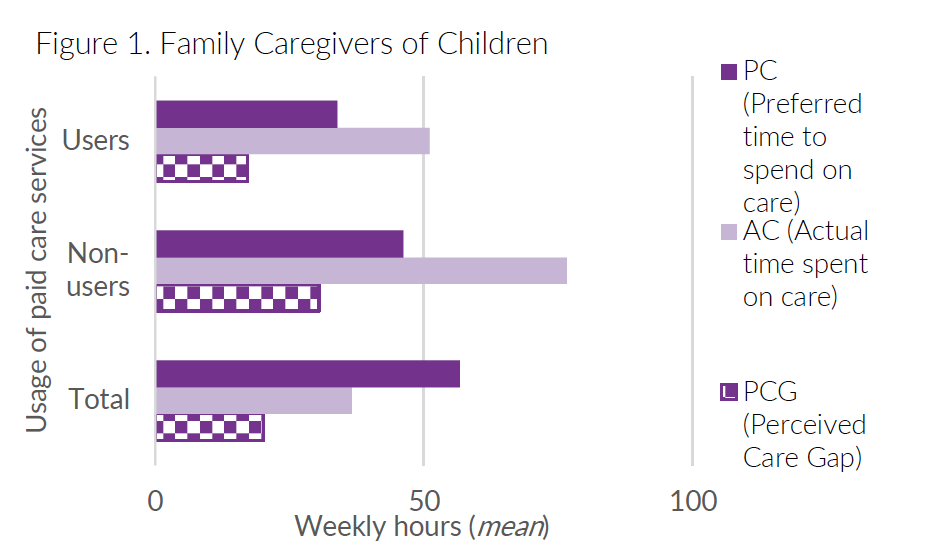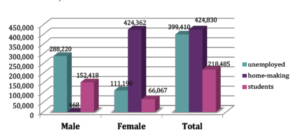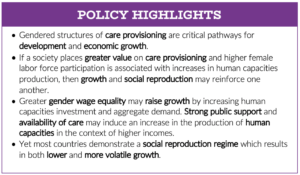Policy Briefs
 South Korea's covid-19 response to address urgent childcare needs
South Korea's covid-19 response to address urgent childcare needs
Brief prepared by: Jungwon Kim & Hanuel Kim
The coronavirus outbreak has led to several unprecedented changes to South Korea. While COVID-19 is primarily an issue of health, it also had a prominent impact on the wellbeing of many individuals. Closure of schools and care centers and restrictions imposed on various social care services exacerbated the burden of care on families, especially women, who shoulder the largest share of the care burden imposed by South Korea’s growing demographic challenges – declining fertility rates and rapid population aging. In light of this, strengthening the care infrastructure is an absolute must in overcome the global pandemic and its repercussions.
 GENDER WAGE EQUALITY AND INVESTMENTS IN CARE: MODELING EQUITY AND PRODUCTION
GENDER WAGE EQUALITY AND INVESTMENTS IN CARE: MODELING EQUITY AND PRODUCTION
Brief prepared by: Elissa Braunstein & Daniele Tavani
Economies are “care-led” when care plays an important role in driving economic outcomes. These economies demonstrate strong “caring spirits” determined by social norms, individual or public preferences to provide care for one’s self and others. For complete details of the model and discussion of related literature, please see the full working paper published to the Care Work and the Economy website here.
 CARE CONUNDRUM IN SOUTH KOREA: IS THERE UNMET DEMAND FOR CHILDCARE AND ELDERCARE
CARE CONUNDRUM IN SOUTH KOREA: IS THERE UNMET DEMAND FOR CHILDCARE AND ELDERCARE
Brief prepared by: Seung-Eun Cha, Eunhye Kang, Shirin Arslan, & Arnob Alam
Korea currently faces a puzzling situation that is also emerging in other high and upper middle-income countries: the continued provisioning of family care for the frail elderly and young children in excess, despite the ample supply of formal (paid) care workers.
 ESTIMATING THE UNPAID CARE SECTOR IN SOUTH KOREA
ESTIMATING THE UNPAID CARE SECTOR IN SOUTH KOREA
Brief prepared by: Joo Yeoun Suh & Hannah L. Randolph
Unpaid care work performed in households is productive work, but is often implicitly considered unproductive because it is beyond the conventional production boundaries (i.e., not included in systems of national account (SNA) measures). This paper estimates both the amount of unpaid care provided and the cost of hiring paid care workers to replace the work done by unpaid care workers in South Korea in 2009 and 2014. For complete details of the model and discussion of related literature, please see the full working paper published to the Care Work and the Economy website here.
 ESTIMATING THE PAID CARE SECTOR IN SOUTH KOREA
ESTIMATING THE PAID CARE SECTOR IN SOUTH KOREA
Brief prepared by: Joo Yeoun Suh & Hannah L. Randolph
This paper produces new estimates of the size, median earnings, and weekly hours of the paid care sector in South Korea. It pulls data from four separate statistical sources to achieve this goal, highlighting the lack of centralized statistics and visibility for paid care workers in South Korea. For complete details of the model and discussion of related literature, please see the full working paper published to the Care Work and the Economy website here.
CARE ARRANGEMENT AND ACTIVITIES IN SOUTH KOREA: AN ANALYSIS OF THE 2018 CARE WORK FAMILY SURVEY ON CHILDCARE AND ELDERCARE
English version: Download Policy Brief
Korean version: Download Policy Brief
Brief prepared by: Eun-hye Kang
Some of the policy highlights of this research are the following: The majority of children are enrolled in facility-based care during the day, but this proportion starts to fall drastically after 3 pm and with a replacement of care by mothers. Likewise, eldercare is concentrated on a primary caregiver in a family. There is a need for public efforts to enhance equitable share of care works among family members. For complete details of the model and discussion of related literature, please see the full working paper published to the Care Work and the Economy website here.
 THE IMPACT OF INVESTING IN SOCIAL CARE ON EMPLOYMENT GENERATION, TIME-AND INCOME-POVERTY AND GENDER GAPS: A MACRO-MICRO POLICY SIMULATION FOR TURKEY
THE IMPACT OF INVESTING IN SOCIAL CARE ON EMPLOYMENT GENERATION, TIME-AND INCOME-POVERTY AND GENDER GAPS: A MACRO-MICRO POLICY SIMULATION FOR TURKEY
Brief prepared by: Ipek Ilkkaracan, Kijong Kim, Tom Masterson, Emel Memis, Ajit Zacharias, and Catherine Hensly
This study presents a macro- and micro-analysis to estimate the effects of increased government spending on social care in Turkey, an upper-middle-income country.1 Spending increases are focused on the early childhood education and care (ECEC) sector to close the care deficit against the policy target of OECD average enrollment rates for preschool children by age group. For complete details of the model and discussion of related literature, please see the full working paper published to the Care Work and the Economy website here, and the accompanying policy note here.
 A GENDERED SOCIAL ACCOUNTING MATRIX FOR SOUTH KOREA
A GENDERED SOCIAL ACCOUNTING MATRIX FOR SOUTH KOREA
English version: Download Policy Brief
Korean version: Download Policy Brief
Brief prepared by: Hans Lofgren, Kijong Kim, Marzia Fontana, & Martin Cicowiez
SAMs are valuable inputs into economic research, primarily used to describe the structure of an economy and as inputs to the databases of Computable General Equilibrium (CGE) models. A CGE model linked to a SAM with this treatment can analyze the economy-wide effects of decisions and policies related to care and gender. For complete details of the model and discussion of related literature, please see the full working paper published to the Care Work and the Economy website here.
 PARENTAL CAREGIVING AND HOUSEHOLD DYNAMICS
PARENTAL CAREGIVING AND HOUSEHOLD DYNAMICS
Brief prepared by: Ray Miller & Neha Bairoliya
As populations continue to age in many countries, the demand for eldercare likewise continues to increase. Unpaid, informal workers—i.e. family members like adult children—provide much of this care. Women often provide much of this care in addition to their market work and home production responsibilities, creating a “triple burden” of market work, home production, and caregiving. For complete details of the model and discussion of related literature, please see the full working paper published to the Care Work and the Economy website here.
 Options for modeling the distributional impact of care policies using a general equilibrium (cge) framework
Options for modeling the distributional impact of care policies using a general equilibrium (cge) framework
English version: Download Policy Brief
Korean version: Download Policy Brief
Brief prepared by: Marzia Fontana, Binderiya Byambasuren & Carmen Estrades
Economy-wide models are insightful in assessing alternative approaches to provide and finance care policies. CGE models are an example of such tools and is the focus of the Care Work and the Economy working paper 20-03. CGE models represent the functioning of an entire economy, in which the researcher specifies the decision-making processes of households and firms and applies the model to detailed empirical data. For complete details of the model and discussion of related literature, please see the full working paper published to the Care Work and the Economy website here.
 MICROFINANCE AND THE CARE ECONOMY
MICROFINANCE AND THE CARE ECONOMY
Brief prepared by: Ramaa Vasudevan, Srinivas Raghavendran & Catherine Hensly
Microfinance encompasses small loans provided to low-income individuals to start small enterprises and has been touted as endgame in development policy for tackling poverty while also promoting women’s empowerment. Yet its effects on the care-economy and wider macro-economy are not well understood. For complete details of the model and discussion of related literature, please see the full working paper published to the Care Work and the Economy website here.
 THE EFFECTS OF PUBLIC SOCIAL INFRASTRUCTURE AND GENDER EQUALITY ON OUTPUT AND EMPLOYMENT: THE CASE OF SOUTH KOREA
THE EFFECTS OF PUBLIC SOCIAL INFRASTRUCTURE AND GENDER EQUALITY ON OUTPUT AND EMPLOYMENT: THE CASE OF SOUTH KOREA
English version: Download Policy Brief
Korean version: Download Policy Brief
Brief prepared by: Cem Oyvat, Özlem Onaran & Catherine Hensly
This paper extends the model introduced in Onaran, Oyvat, and Fotopoulou (2019) to analyze the effects of the gender pay gap and public spending in education, childcare, and social care on aggregate output and employment in South Korea.1 Analysis of the South Korean case shows that a combination of labor market and fiscal policies is necessary to achieve sustainable, equitable development with substantial increases in employment. For complete details of the model and discussion of related literature, please see the full working paper published to the Care Work and the Economy website here.
 ESTIMATING THE ROLE OF SOCIAL REPRODUCTION IN ECONOMIC GROWTH
ESTIMATING THE ROLE OF SOCIAL REPRODUCTION IN ECONOMIC GROWTH
English version: Download Policy Brief
Korean version: Download Policy Brief
Brief prepared by: Elissa Braunstein, Stephanie Seguino, Levi Altringer & Catherine Hensly
This paper develops a conceptual macroeconomic model of growth and social reproduction. It emphasizes how norms and preferences around care provision interact with the structure of the macroeconomy to influence outcomes. Model predictions are tested to understand how distributions of production and reproduction among women, men, the state, and capital affect the dynamics of economic growth. For complete details of the model and discussion of related literature, please see the full working paper published to the Care Work and the Economy website here
 ACCESS TO INFRASTRUCTURE, WOMEN’S TIME ALLOCATION, AND ECONOMIC GROWTH
ACCESS TO INFRASTRUCTURE, WOMEN’S TIME ALLOCATION, AND ECONOMIC GROWTH
Brief prepared by: Pierre-Richard Agénor, Madina Agénor & Catherine Hensly
This paper emphasizes the relationship between access to infrastructure and women’s time allocations between home production, child-rearing, and the labor market by developing a simple two-period, gender-based overlapping generations (OLG) model. These time-allocation decisions are shown to influence significantly the growth outcomes in low-income developing countries. For complete details of the model and discussion of related literature, please see the full working paper published to the Care Work and the Economy website here
 ENDOGENOUS GROWTH, POPULATION
ENDOGENOUS GROWTH, POPULATION  DYNAMICS, AND RETURNS TO SCALE: LONG-RUN MACROECONOMICS WHEN DEMOGRAPHY MATTERS
DYNAMICS, AND RETURNS TO SCALE: LONG-RUN MACROECONOMICS WHEN DEMOGRAPHY MATTERS
English version: Download Policy Brief
Korean version: Download Policy Brief
Brief prepared by: James Heintz, Nancy Folbre & Catherine Hensly
Demographics and returns to scale (decreasing, constant, or increasing) matter when modeling long-run economic growth. Research demonstrates that family size decisions respond to economic conditions and the resulting fertility outcomes collectively drive population growth (or shrinkage). For complete details of the model and discussion of related literature, please see the full working paper published to the Care Work and the Economy website here.
 Gendering Macroeconomic Analysis and Development: A Theoretical Model for Gender Equitable Development
Gendering Macroeconomic Analysis and Development: A Theoretical Model for Gender Equitable Development
English version: Download Policy Brief
Korean version: Download Policy Brief
Brief prepared by: Özlem Onaran, Cem Oyvat, Eurydice Fotopoulou & Catherine Hensly
The CWE-GAM team presents an engendered macroeconomic model as a tool to analyze the role of gender equality and fiscal policy on growth and development. The model incorporates realistic structural features of a market economy –such as excess production capacity and involuntary unemployment– and incorporates an unpaid reproductive sector as well as the physical and social sectors in the public and private market economy. The addition of the unpaid reproductive sector explicitly incorporates the provision of domestic care, establishing a more holistic representation of how the workforce is kept fed, healthy, and able to work. This three-sector model is designed to serve as a tool for policy analysis and gender-responsive budgeting to develop a policy mix targeted toward more gender-equitable development. This brief provides a general overview of the model and example policy analyses. For complete details of the model and discussion of related literature, please see the full working paper published to the Care Work and the Economy website here

